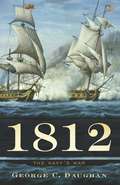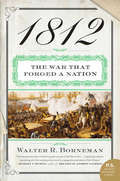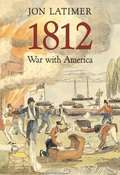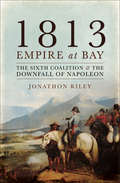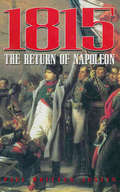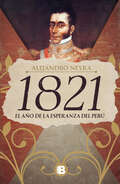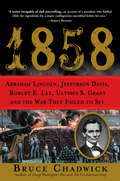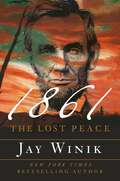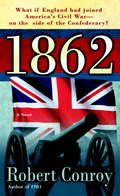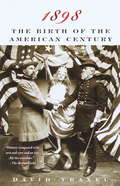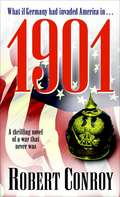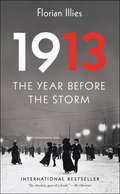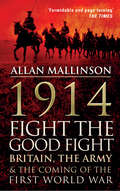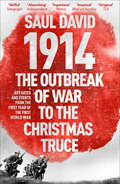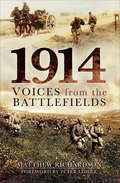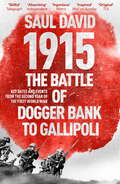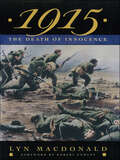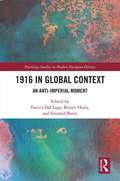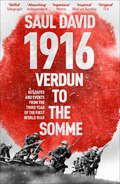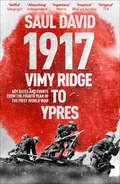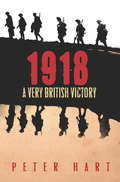- Table View
- List View
1812: The Navy's War
by George C. DaughanAt the outbreak of the War of 1812, America’s prospects looked dismal. It was clear that the primary battlefield would be the open ocean-but America’s war fleet, only twenty ships strong, faced a practiced British navy of more than a thousand men-of-war. Still, through a combination of nautical deftness and sheer bravado, the American navy managed to take the fight to the British and turn the tide of the war: on the Great Lakes, in the Atlantic, and even in the eastern Pacific. In 1812: The Navy’s War, prizewinning historian George C. Daughan tells the thrilling story of how a handful of heroic captains and their stalwart crews overcame spectacular odds to lead the country to victory against the world’s greatest imperial power. A stunning contribution to military and national history, 1812: The Navy’s War is the first complete account in more than a century of how the U. S. Navy rescued the fledgling nation and secured America’s future.
1812: The War of 1812 (P. S. Series)
by Walter R. BornemanIn June 1812 the still-infant United States had the audacity to declare war on the British Empire. Fought between creaking sailing ships and armies often led by bumbling generals, the ensuing conflict featured a tit-for-tat "You burned our capital, so we'll burn yours" and a legendary battle unknowingly fought after the signing of a peace treaty. During the course of the war, the young American navy proved its mettle as the USS Constitution, "Old Ironsides," sent two first-rate British frigates to the bottom, and a twenty-seven-year-old lieutenant named Oliver Hazard Perry hoisted a flag exhorting, "Don't Give Up the Ship," and chased the British from Lake Erie. By 1814, however, the United States was no longer fighting for free trade, sailors' rights, and as much of Canada as it could grab, but for its very existence as a nation. With Washington in flames, only a valiant defense at Fort McHenry saved Baltimore from a similar fate. Here are the stories of commanding generals such as America's Henry "Granny" Dearborn, double-dealing James Wilkinson, and feisty Andrew Jackson, as well as Great Britain's gallant Sir Isaac Brock, overly cautious Sir George Prevost, and Rear Admiral George Cockburn, the man who put the torch to Washington. Here too are those inadvertently caught up in the war, from heroine farm wife Laura Secord, whom some call Canada's Paul Revere, to country doctor William Beanes, whose capture set the stage for Francis Scott Key to write "The Star-Spangled Banner." 1812: The War That Forged a Nation presents a sweeping narrative that emphasizes the struggle's importance to America's coming-of-age as a nation. Though frequently overlooked between the American Revolution and the Civil War, the War of 1812 did indeed span half a continent -- from Mackinac Island to New Orleans, and Lake Champlain to Horseshoe Bend -- and it paved the way for the conquest of the other half. During the War of 1812, the United States cast aside its cloak of colonial adolescence and -- with both humiliating and glorious moments -- found the fire that was to forge a nation.
1812: War with America
by Jon LatimerThe British viewed the War of 1812 as an ill-fated attempt by the young American republic to annex Canada. For British Canada, populated by many loyalists who had fled the American Revolution, this was a war for survival. The Americans aimed both to assert their nationhood on the global stage and to expand their territory northward and westward. Americans would later find in this war many iconic moments in their national story--the bombardment of Fort McHenry (the inspiration for Francis Scott Key's "Star Spangled Banner"); the Battle of Lake Erie; the burning of Washington; the death of Tecumseh; Andrew Jackson's victory at New Orleans--but their war of conquest was ultimately a failure. Even the issues of neutrality and impressment that had triggered the war were not resolved in the peace treaty. For Britain, the war was subsumed under a long conflict to stop Napoleon and to preserve the empire. The one lasting result of the war was in Canada, where the British victory eliminated the threat of American conquest, and set Canadians on the road toward confederation. Latimer describes events not merely through the eyes of generals, admirals, and politicians but through those of the soldiers, sailors, and ordinary people who were directly affected. Drawing on personal letters, diaries, and memoirs, he crafts an intimate narrative that marches the reader into the heat of battle.
1813: The Sixth Coalition & the Downfall of Napoleon
by Jonathon RileyA distinguished historian and British Army veteran examines the political and military alliances that led to the defeat of France in the Napoleonic Wars. 1813 was a critical year in the war that ended with the downfall of Napoleon—the year in which the balance of power tipped decisively against the French monarch&’s First Empire. In 1813: Empire at Bay, military historian and retired British Army Lt. Gen. Jonathon Riley explores the international alliance behind the major campaigns that raged across Europe and ultimately broke France&’s power. Focusing on the nations of the Sixth Coalition—Austria, Prussia, Russia, the United Kingdom, Portugal, Sweden, Spain, and the smaller German states—Riley reveals how this unprecedented alliance became the prototype of all uneasy modern coalitions. Despite their common enemy and shared goals, the international leaders and military officers had to navigate troubled command relationships, disagreements on strategy and operations, and clashing political ambitions. Riley also reassesses Napoleon&’s strengths and faults as an alliance commander, overseeing armies of not only Frenchmen but also Poles, Danes, Italians, Germans, and a host of other contingents. In vivid detail, Riley&’s groundbreaking book covers the battles of Lützen, Bautzen, Dresden, and Leipzig, demonstrating how they were each in their own way a decisive step toward Napoleon&’s defeat at Waterloo.
1815: The Return of Napoleon (The\napoleonic Library)
by Paul Britten AustinThe dramatic story of Napoleon&’s escape from Elba and march on Paris—in the words of eyewitnesses and participants. Drawing on hundreds of firsthand accounts by Napoleon&’s supporters and opponents, Paul Britten Austin recreates the drama of those tumultuous days of the spring of 1815 and throws light on the mixed French response to the unexpected return of their former emperor. 1815: The Return of Napoleon recreates, in the words of those present, Napoleon&’s dramatic landing at Antibes in the south of France; the first heady days of his arrival after almost a year of exile; his almost miraculous march across France; his arrival in Paris; and the coup which led to the fall of the Bourbons. Paul Britten Austin, author of an acclaimed trilogy on Napoleon&’s invasion of Russia, brings historical events to life and gives a dramatic insight into the hopes and fears of the French nation in that spring of 1815.
1821: El año de la esperanza del Perú
by Alejandro NeyraEn 1821, Alejandro Neyra relata los episodios fundamentales de aquel año decisivo que cambió el rumbo de nuestra historia. ¿Cómo se originó la gesta por la Independencia del Perú? ¿Quiénes fueron los personajes que diseñaron las estrategias y las negociaciones para acabar con el virreinato e instaurar la República? En 1821, Alejandro Neyra relata los episodios fundamentales de aquel año decisivo que cambió el rumbo de nuestra historia. Este libro narra las comunicaciones y los encuentros entre el marqués de Torre Tagle y don José de San Martín y sus huestes para formar una alianza con la única misión de luchar por la libertad. Conspiraciones, acuerdos fallidos y amistades sólidas se encuentran en las páginas de este libro. Neyra da vida a los protagonistas de esta historia en cuyos diálogos descubrimos un profundo deseo de justicia y de cambio en la vida social, marcada por el temor de hallarse entre dos bandos y la necesidad de escoger uno de ellos. En 1821 destaca la participación de Rosa Campusano, Carmen Guzmán, Mariana Echevarría y Basil Hall, entre otros personajes que contribuyeron a la Independencia y a los que, cumplido el Bicentenario, este libro busca dar justo homenaje. «1821 nos muestra cómo se vivió la Independencia en el norte del Perú y en Lima, llena de color la historia que conocemos y nos ayuda a imaginar lo que dijeron y vivieron sus protagonistas». Natalia Sobrevilla Perea
1858: Abraham Lincoln, Jefferson Davis, Robert E. Lee, Ulysses S. Grant and the War They Failed to See
by Bruce Chadwick1858 explores the events and personalities of the year that would send the America's North and South on a collision course culminating in the slaughter of 630,000 of the nation's young men, a greater number than died in any other American conflict. The record of that year is told in seven separate stories, each participant, though unaware, is linked to the oncoming tragedy by the central, though ineffective, figure of that time, the man in the White House, President James Buchanan. The seven figures who suddenly leap onto history's stage and shape the great moments to come are: Jefferson Davis, who lived a life out of a Romantic novel, and who almost died from herpes simplex of the eye; the disgruntled Col. Robert E. Lee, who had to decide whether he would stay in the military or return to Virginia to run his family's plantation; William Tecumseh Sherman, one of the great Union generals, who had been reduced to running a roadside food stand in Kansas; the uprising of eight abolitionists in Oberlin, Ohio, who freed a slave apprehended by slave catchers, and set off a fiery debate across America; a dramatic speech by New York Senator William Seward in Rochester, which foreshadowed the civil war and which seemed to solidify his hold on the 1860 Republican Presidential nomination; John Brown's raid on a plantation in Missouri, where he freed several slaves, and marched them eleven hundred miles to Canada, to be followed a year later by his catastrophic attack on Harper's Ferry; and finally, Illinois Senator Steven Douglas' seven historic debates with little-known Abraham Lincoln in the Illinois Senate race, that would help bring the ambitious and determined Lincoln to the Presidency of the United States. As these stories unfold, the reader learns how the country reluctantly stumbled towards that moment in April 1861 when the Southern army opened fire on Fort Sumter.
1861: The Lost Peace
by Jay WinikFrom an award-winning historian and New York Times bestselling author, a gripping, fly-on-the-wall account of the weeks leading up to Abraham Lincoln's decision to go to war against the Confederacy.1861: The Lost Peace is the story of President Lincoln&’s difficult and courageous decision at a time when the country wrestled with deep moral questions of epic proportions. Through Jay Winik&’s singular reporting and storytelling, readers will learn about the extraordinary Washington Peace Conference at the Willard Hotel to avert cataclysmic war. They will observe the irascible and farsighted Senator JJ Crittenden, the tireless moderate seeking a middle way to peace. Lincoln himself called Crittenden &“a great man&” even as Lincoln jousted with him. Readers will glimpse inside Lincoln&’s cabinet—the finest in history—which rivaled the executive in its authority, a fact too often forgotten, and witness a parade of statesmen frenetically grasping for peace rather than the spectacle of a young nation slowly choking itself to death. A perfect read for history buffs, with timely overtones to our current political climate.
1862
by Robert ConroyThe Civil War comes alive in all its passion and fury, only now the Brits are fighting alongside the Confederacy. Outraged when the U.S. Navy seizes three Confederates aboard an English sailing ship, Britain retaliates by entering the fray in support of the Rebels and suddenly it's a whole new war. Once again, cotton is king as the North's blockade crumbles before the might of the Royal Navy. While Lincoln confronts the monumental challenge of vanquishing mighty Britannia, the Redcoats revive their 1812 penchant for burning down American cities, and Union troops see Canada as ripe for the picking. From the Mississippi bayou to the Pennsylvania farmlands to the woods of Maine, the great armies of Generals Grant and Lee face off in the nation's deadliest conflict. And to the victor goes history.
1898: The Birth of the American Century
by David TraxelHistorian Traxel narrates the extraordinary events of 1898 to unfold the story of America's metamorphosis from a rural, isolationist society into a commanding presence on the world stage. The account centers upon America's first foray into international military affairs, the Spanish-American War, but also covers worker uprisings, racial conflict, the last battle between Native Americans and the US Army, advances in technology, and the growing importance of advertising. Annotation c. by Book News, Inc. , Portland, Or.
1901: A Thrilling Novel of a War that Never Was
by Robert ConroyThe year is 1901. Germany's navy is the second largest in the world; their army, the most powerful. But with the exception of a small piece of Africa and a few minor islands in the Pacific, Germany is without an empire. Kaiser Wilhelm II demands that the United States surrender its newly acquired territories: Guam, Puerto Rico, Cuba, and the Philippines. President McKinley indignantly refuses, so with the honor and economic future of the Reich at stake, the Kaiser launches an invasion of the United States, striking first on Long Island. Now the Americans, with their army largely disbanded, must defend the homeland. When McKinley suffers a fatal heart attack, the new commander in chief, Theodore Roosevelt, rallies to the cause, along with Confederate general James Longstreet. From the burning of Manhattan to the climactic Battle of Danbury, American forces face Europe's most potent war machine in a blazing contest of will against strength.
1913
by Shaun Whiteside Florian Illies Jamie Lee SearleJust before one of its darkest moments came the twentieth century's most exciting year . . .It was the year Henry Ford first put a conveyer belt in his car factory, and the year Louis Armstrong first picked up a trumpet. It was the year Charlie Chaplin signed his first movie contract, and Coco Chanel and Prada opened their first dress shops. It was the year Proust began his opus, Stravinsky wrote The Rite of Spring, and the first Armory Show in New York introduced the world to Picasso and the world of abstract art. It was the year the recreational drug now known as ecstasy was invented.It was 1913, the year before the world plunged into the catastrophic darkness of World War I.In a witty yet moving narrative that progresses month by month through the year, and is interspersed with numerous photos and documentary artifacts (such as Kafka's love letters), Florian Illies ignores the conventions of the stodgy tome so common in "one year" histories. Forefronting cultural matters as much as politics, he delivers a charming and riveting tale of a world full of hope and unlimited possibility, peopled with amazing characters and radical politics, bristling with new art and new technology . . . even as ominous storm clouds began to gather.From the Hardcover edition.
1914: Britain, the Army and the Coming of the First World War
by Allan Mallinson‘No part of the Great War compares in interest with its opening’, wrote Churchill. ‘The measured, silent drawing together of gigantic forces, the uncertainty of their movements and positions, the number of unknown and unknowable facts made the first collision a drama never surpassed…in fact the War was decided in the first twenty days of fighting, and all that happened afterwards consisted in battles which, however formidable and devastating, were but desperate and vain appeals against the decision of fate.’On of Britain's foremost military historians and defence experts tackles the origins - and the opening first few weeks of fighting - of what would become known as 'the war to end all wars'. Intensely researched and convincingly argued, Allan Mallinson explores and explains the grand strategic shift that occurred in the century before the war, the British Army’s regeneration after its drubbings in its fight against the Boer in South Africa, its almost calamitous experience of the first twenty days’ fighting in Flanders to the point at which the British Expeditionary Force - the 'Old Contemptibles' - took up the spade in the middle of September 1914: for it was then that the war changed from one of rapid and brutal movement into the more familiar vision of trench warfare on Western Front. In this vivid, compelling new history, Malliinson brings his experience as a professional soldier to bear on the circumstances, events, actions and individuals and speculates – tantalizingly – on what might have been...
1914: Key Dates and Events from the First Year of the First World War
by Saul DavidThis special ebook has been created by historian Saul David from his acclaimed work 100 Days to Vistory: How the Great War was Fought and Won, which was described by the Mail on Sunday as 'Inspired' and by Charles Spencer as 'A work of great originality and insight'. Through key dates from 4 August 1914, when Britain declared war, to the Christmas Truce of 24 December 1914, Saul David's gripping narrative is an enthralling tribute to a generation of men and women whose sacrifice should never be forgotten.
1914: The Outbreak of War to the Christmas Truce
by Saul DavidThis special ebook has been created by historian Saul David from his acclaimed work 100 Days to Vistory: How the Great War was Fought and Won, which was described by the Mail on Sunday as 'Inspired' and by Charles Spencer as 'A work of great originality and insight'. Through key dates from 4 August 1914, when Britain declared war, to the Christmas Truce of 24 December 1914, Saul David's gripping narrative is an enthralling tribute to a generation of men and women whose sacrifice should never be forgotten.
1914: Voices from the Battlefields
by Matthew RichardsonThe opening battles of WWI&’s Western Front and the world-changing advances in warfare are reexamined through eyewitness accounts from the trenches. The 1914 campaign of World War I, sparked by the German Army&’s invasion of Luxembourg, Belgium, and France, marked a watershed in military history. Advances in weaponry forced both sides to take to the earth in what became a grueling standoff of trench warefare. In a bizarre mix of ancient and modern, some of the last cavalry charges took place in the same theatre in which armoured cars, motorcycles and aeroplanes were beginning to make their presence felt. These dramatic developments were recorded in graphic detail by soldiers who were there in the trenches themselves. Now, with the benefit of these firsthand accounts, historian Matthew Richardson offers a thoroughgoing reassessment of the 1914 campaign. His vivid narrative emphasises the perspective of the private soldiers and junior officers of the British Army and includes full colour plates containing over one hundred illustrations. 1914: Voices from the Battlefields was a Britain At War Magazine Book of the Month in February 2014.
1915: Key Dates and Events from the Second Year of the First World War
by Saul DavidThis special ebook has been created by historian Saul David from his acclaimed work 100 Days to Vistory: How the Great War was Fought and Won, which was described by the Mail on Sunday as 'Inspired' and by Charles Spencer as 'A work of great originality and insight'. Through key dates from the Battle of Dogger Bank on 24th January 1914, to the Gallipoli landings, Saul David's gripping narrative is an enthralling tribute to a generation of men and women whose sacrifice should never be forgotten.
1915: The Battle of Dogger Bank to Gallipoli
by Saul DavidThis special ebook has been created by historian Saul David from his acclaimed work 100 Days to Vistory: How the Great War was Fought and Won, which was described by the Mail on Sunday as 'Inspired' and by Charles Spencer as 'A work of great originality and insight'. Through key dates from the Battle of Dogger Bank on 24th January 1914, to the Gallipoli landings, Saul David's gripping narrative is an enthralling tribute to a generation of men and women whose sacrifice should never be forgotten.
1915: The Death of Innocence
by Lyn MacdonaldLyn Macdonald's 1915: The Death of Innocence is a uniquely compelling blend of military history and poignant memories of the fighters who survived the ordeal. By Christmas 1915, the wild wave of enthusiasm that had sent men flocking to join up a few months earlier had begun to tail off, and though the Regulars of the original Expeditionary Force had suffered 90 percent casualties, most, particularly the soldiers themselves, still believed that 1915 would see the breaking of the deadlock. Their hopes were shattered on the bloody battlefields at Neuve Chapelle, at Ypres, at Loos, and far away on the shores of Gallipoli. Generals failed to understand the importance of heavy howitzers and machine guns, convinced that wars were won by the cavalry. They could not imagine a war in which hundreds of advancing troops could be wiped out in minutes by machine-gun fire. As disillusionment began to set in and grim resolve replaced easy optimism, innocence was among the casualties in the trenches that ran through the Flanders swamps. The story of 1915 is stark, brutal, frank, sometimes painfully funny, always human. Above all, it is history from the ground up, told from the point of view of the men themselves. Never before has any writer collected so many firsthand accounts of the experiences of ordinary soldiers, through diaries, letters, and interviews with survivors--and it is the dogged heroism and sardonic humor of the soldiers that shine through the pages of Lyn Macdonald's epic narrative.
1916 in Global Context: An anti-Imperial moment (Routledge Studies in Modern European History)
by Enrico Dal Lago Róisín Healy Gearóid BarryThe year 1916 has recently been identified as "a tipping point for the intensification of protests, riots, uprisings and even revolutions." Many of these constituted a challenge to the international pre-war order of empires, and thus collectively represent a global anti-imperial moment, which was the revolutionary counterpart to the later diplomatic attempt to construct a new world order in the so-called Wilsonian moment. Chief among such events was the Easter Rising in Ireland, an occurrence that took on worldwide significance as a challenge to the established order. This is the first collection of specialist studies that aims at interpreting the global significance of the year 1916 in the decline of empires.
1916: Key Dates and Events from the Third Year of the First World War
by Saul DavidThis special ebook has been created by historian Saul David from his acclaimed work 100 Days to Victory: How the Great War was Fought and Won, which was described by the Mail on Sunday as 'Inspired' and by Charles Spencer as 'A work of great originality and insight'. Through key dates from the introduction of conscription in Britain on 27 January 1916, to the first day of the Somme on 1 July 1916, Saul David's gripping narrative is an enthralling tribute to a generation of men and women whose sacrifice should never be forgotten.
1916: Verdun to the Somme
by Saul DavidThis special ebook has been created by historian Saul David from his acclaimed work 100 Days to Victory: How the Great War was Fought and Won, which was described by the Mail on Sunday as 'Inspired' and by Charles Spencer as 'A work of great originality and insight'. Through key dates from the introduction of conscription in Britain on 27 January 1916, to the first day of the Somme on 1 July 1916, Saul David's gripping narrative is an enthralling tribute to a generation of men and women whose sacrifice should never be forgotten.
1917: Key Dates and Events from the Fourth Year of the First World War
by Saul DavidThis special ebook has been created by historian Saul David from his acclaimed work 100 Days to Victory: How the Great War was Fought and Won, which was described by the Mail on Sunday as 'Inspired' and by Charles Spencer as 'A work of great originality and insight'. Through key dates from the abdication of Tsar Nicholas II, to the capture of Jerusalem, Saul David's gripping narrative is an enthralling tribute to a generation of men and women whose sacrifice should never be forgotten.
1917: Key Dates and Events from the Fourth Year of the First World War
by Saul DavidThis special ebook has been created by historian Saul David from his acclaimed work 100 Days to Victory: How the Great War was Fought and Won, which was described by the Mail on Sunday as 'Inspired' and by Charles Spencer as 'A work of great originality and insight'. Through key dates from the abdication of Tsar Nicholas II, to the capture of Jerusalem, Saul David's gripping narrative is an enthralling tribute to a generation of men and women whose sacrifice should never be forgotten.
1918: A Very British Victory
by Peter HartThe story of the huge mobile battles of 1918, which finally ended the Great War.1918 was the critical year of battle as the Great War reached its brutal climax. Warfare of an epic scale was fought on the Western Front, where ordinary British soldiers faced the final test of their training, tactics and determination. That they withstood the storm and began an astonishing counterattack, is proof that by 1918, the British army was the most effective fighting force in the world. But this ultimate victory came at devastating cost.Using a wealth of previously unpublished material, historian Peter Hart gives a vivid account of this last year of conflict - what it was like to fight on the frontline, through the words of the men who were there. In a chronicle of unparalleled scope and depth, he brings to life the suspense, turmoil and tragedy of 1918's vast offensives.
